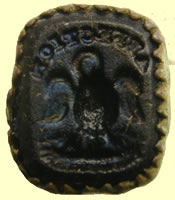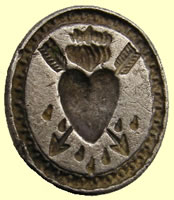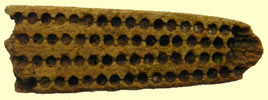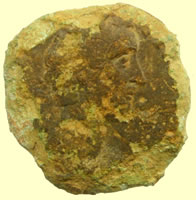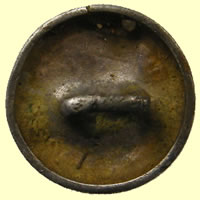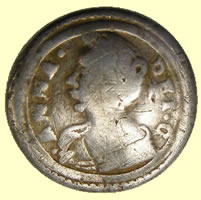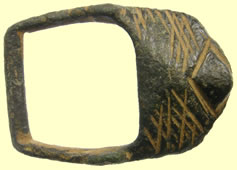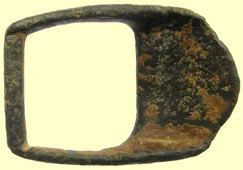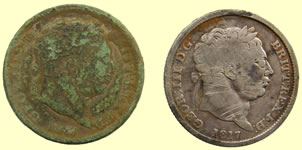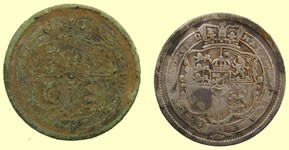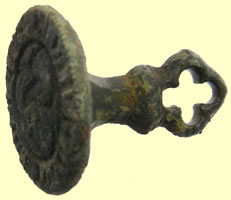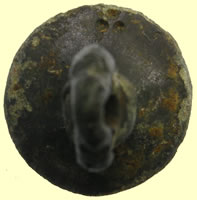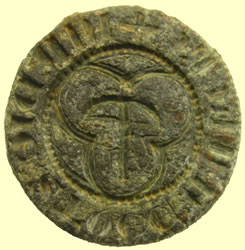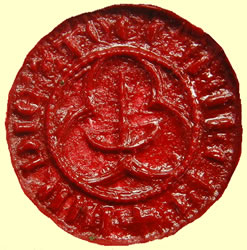

Metal detecting holidays in England with the World's most successful metal detecting club.
Twinned with Midwest Historical Research Society USA
| 2013 Feb Finds page |
50 - 20 BC Essex Wheels quarter, VA 260, BMC 485 and 496, ABC 2231. Quite a rare Trinovantian type 1.4g, 14.42mm - sent to CCI for recording and ID confirmation. The quarter you sent is an Essex Wheels type as you say, all ID correct and I've recorded it as 12.0697 (the BM haven't sent my allocation of 2013 numbers yet, still using last years). John |
||
Neat georgian fob seal matrix |
||
17thC Charles II circa 1670 silver seal matrix - reported to Colchester museum as treasure |
||
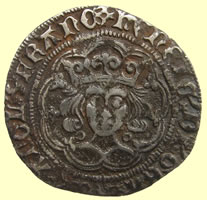 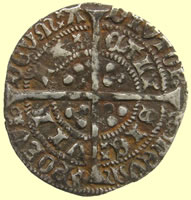 |
||
1422- 27 Henry VI hammered silver groat - Annulet issue - 2 sets of opposing pellets on reverse - IM pierced cross Obv HENRIC DI GRA REX ANGL Z FRANC Rev VILLA CALISIE - Calais mint |
||
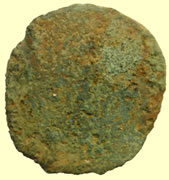 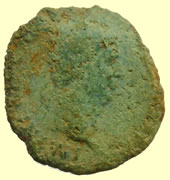 |
||
2ndC Roman bronze coin sent for ID My first guess, since this appears to be a Julio-Claudian portrait, and the overwhelming majority of early Julio-Claudian portraits on Æ's are to the left - except for one issuer. So I originally believed this was Claudius - 41-54 AD. Nero also has quite a few right-facing portraits on Æ's, but this portrait simply doesn't look like Nero - and Nero didn't have any single standing-figure reverses on Sestertii - Claudius, on the other hand, did use standing personifications. Unfortunately, the portrait doesn't look a whole lot like the more common portrayal of Claudius, either, where he is shown with an almost freakishly long neck. The only letters of obverse legend I can see are, apparently, "IM..." the beginning of IMP... - and Claudius' obverse legends overwhelmingly begin "TI CAESAR..." What I'm left with as a possibility then is a sestertius or dupondius (they were pretty large in many cases at this time) of Galba - 68-9 AD.. There is a PAX standing reverse on a dupondius of Galba which exhibits the same posture as the standing figure on the back of this one appears to have. Galba is scarce to rare - Claudius is fairly common and one of his most common sestertius types is Spes left - walking, but looking pretty static on most examples. It would have to be a very unusual legend variety for Claudius, however, to begin IMP rather than TI CAESAR. Mark |
||
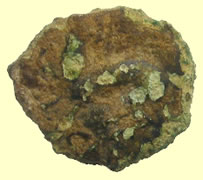 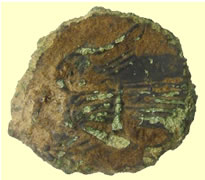 |
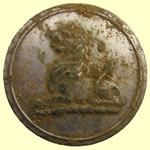 |
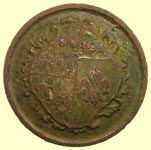 |
Celtic bronze unit - sent to CCI for ID and recording The bronze is definitely Celtic, the obverse has a right-facing bust with 'wings' behind similar to those on the obverse of Whaddon Chase staters but even closer to the hair curls on late Gallo-Belgic F and Criciru staters of the Suessiones and Meldi, so it may be Gaulish. The reverse has a left-facing horse with what look like the letters CA below, perhaps followed by an M in which case it should read CAMV, but this may be wishful thinking. I've recorded it as 12.0698 All the best John |
19thC livery button | 19thC livery button |
 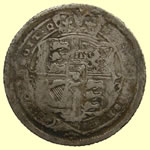 |
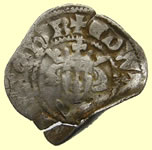 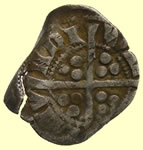 |
|
| 1817 George III milled silver sixpence | 1341 Edward III hammered silver penny - Cross 3 EDWAR *** DNS HYB Rev VILL/SIIIE/DMV/NDI - Bury St Edmunds mint |
|
 |
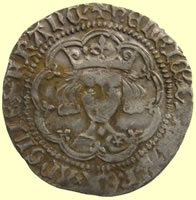 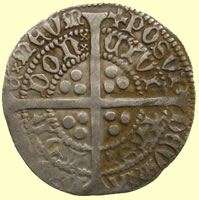 |
|
Cast copper alloy trapezoidal shoe or knee buckle with concave sides 1660-1720 |
1427 - 1430 Henry VI hammered silver groat- Rosette Mascle issue - T in TAS struck over I - Cross type 2 Obv +HENRIC DI ANGLE FRANC Rev CIVI/TAS/LON/DON - London mint |
|
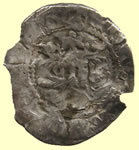 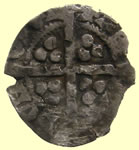 |
  |
|
1341 Edward III hammered silver penny - London mint |
1215 Henry III hammered silver half penny | |
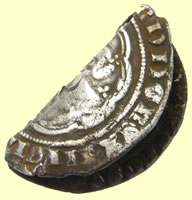 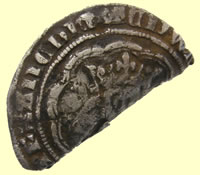 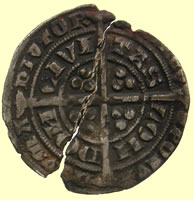 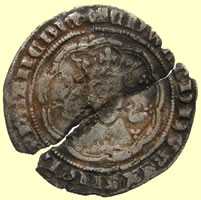 |
||
| Fixed taco'd
1369-77 Edward III hammered silver groat - Post treaty period - Standard F type Obv EDWARDVS REX ANGL FRANC D HIB Rev CIVI/TAS/LON/DON - London mint |
||
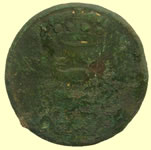  |
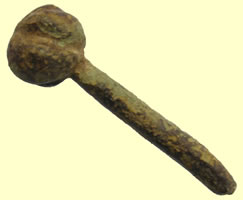 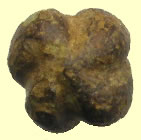 |
|
| 19thC livery button and unusual Georgian button with cross | Roman bronze pin | |
 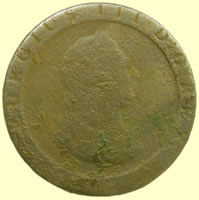 |
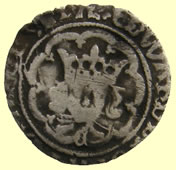  |
||||||
| Nice shape 1797 George III cartwheel 2 pence | Edward IV hammered silver half groat - C on breast Trefoils over crown - IM Rose Large 2nd reign Canterbury April 1471 - April 1483 Obv EDWARD DI GRA REX ANGL Z FRA Rev CIVI/TAS/CAN/TOR Canterbury mint |
||||||
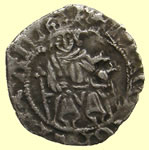 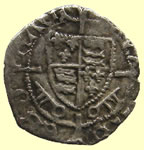 |
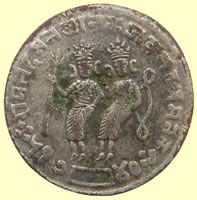 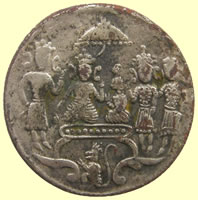 |
||||||
1485 Henry VII hammered silver sovereign penny - Archbishop Rotherham - Keys below shield - York |
India Ram Darbar Temple Token Ramatanka | ||||||
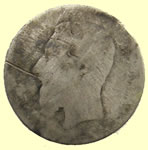 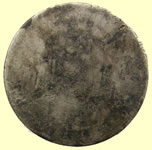 |
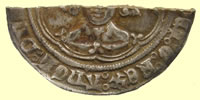 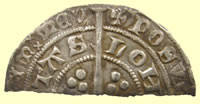 |
||||||
| Foreign milled silver coin - not ID'd it yet |
1361-9 Edward III hammered silver cut half groat - cross potent - Treaty period Obv EDWARDVS DEI G REX ANGL DNS** Rev CIVI/TAS/LON/DON - London mint |
||||||
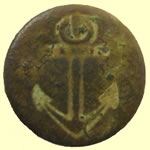 |
 |
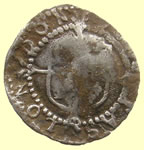 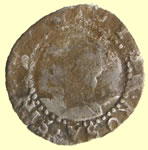 |
|||||
| 1770 Royal Navy button | Victorian Royal Engineers button | 1590 -2 Elizabeth 1st hammered silver penny - hand mintmark | |||||
 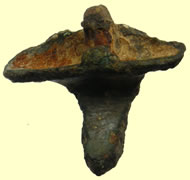 |
  |
||||||
| 2ndC Roman 'head studd' type fibular brooch | Georgian watch winder - Colchester jewelers | ||||||
|
 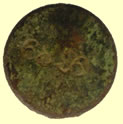 |
||||||
| Interesting twisted wire type brooch - not sure of the date on this one yet | Bell trade weight marked 6826 ? | ||||||
|
 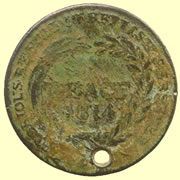 |
||||||
| Interesting eyeball find - 19thC bone tooth brushbrush | 1814 'Emperer' Alexander Napoleonic War Medallion,dated 1814. Diameter is 24 mm.
Inscriptions are "THE EMPEROR ALEXANDER" "THE GLORIOUS RESULT OF BRITISH PERSERVERANCE"
And in the centre "PEACE 1814"
|
||||||
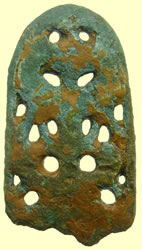  |
|||||||
C8thC Viking fretwork 'ladder of life' strapend - these are well known for being unusually large 53.95mm L x 29.77 mm W |
|||||||
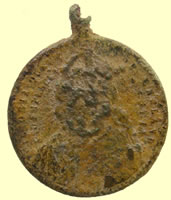 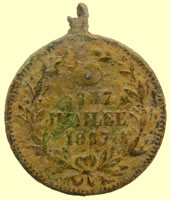 |
 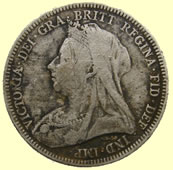 |
||||||
| 1837 -1887 Victoria jubilee medallion | 1893 Victoria milled silver shilling | ||||||
 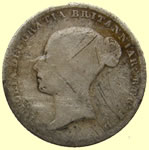 |
|||||||
| 1844 Victoria milled silver sixpence | |||||||
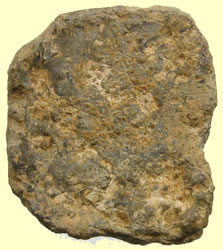 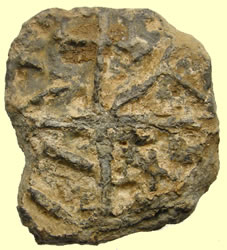 |
|||||||
| Anglo Saxon lead trade weight | |||||||
 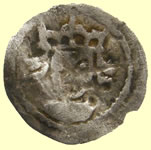 |
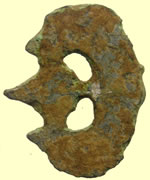 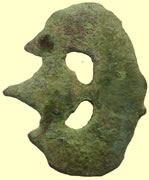 |
||||||
1413 AD Henry V hammered silver penny Quatrefoil with pellet reverse cross
|
Saxon buckle fragment | ||||||
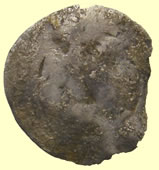 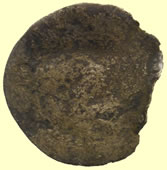 |
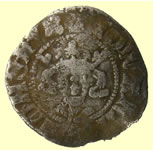 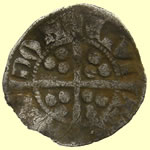 |
||||||
| Eaten to death hammered silver half groat | 1341 Edward III hammered silver penny - Florin issue Obv EDWAR ANGLE DNS HYB Rev CIVI/TAS/LON/DON - London mint |
||||||
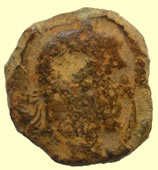 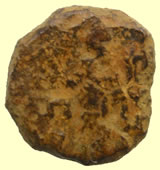 |
|||||||
Very thick heavy 3rdC Roman bronze coin sent for ID 18.25mm x3.15mm thick - 3.65g This has obviously been edge-chipped down to a mere fragment of its original size. It was probably an As, c. 25mm, when it started out, but I'm going to guess this has been in the plowsoil stratum for a century or two at least, being repeatedly hit and turned over. It's really not possible to be certain who's on this, but if that actually is a beard and not just the oddly lumpy surface around the chin area, I'd say offhand that it looks more like Hadrian than anyone else. I can't really tell from the photo just what is going on on the reverse. There appears to be a standing figure to the right of a staple-shaped rectilinear object of some sort. I'm guessing that might have been an altar at one time, and in that proximity to an altar, you'd be most likely to see Pietas sprinkling incense on a flame or Salus feeding a serpent - both of these are very common 2nd century reverse types and either could easily be the reverse type on an As of Hadrian (117-138) - A somewhat distant 2nd guess would be Marcus Aurelius (161-180) but with only a silhouette to work from it's a tough call. It still favors Hadrian by comparison with M. Aurelius, too. Mark
|
|||||||
 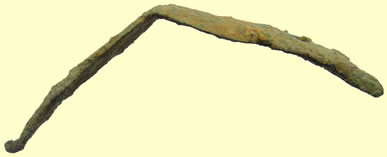 |
|||||||
| Medieval gilded mount | |||||||
 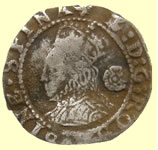 |
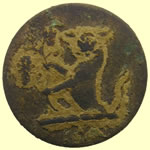 |
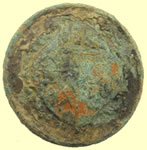 |
|||||
| 1574 Elizabeth 1st hammered silver penny | 19thC livery button | 19thC livery button | |||||
 |
 |
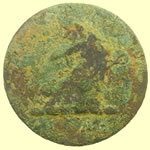 |
|||||
| Tudor purse bar arm ? | 1500-1700 mount | 19thC livery button | |||||
  |
  |
||||||
1369-77 Edward III hammered silver penny - Post Treaty Obv ED*** ANGLI Rev CIVI/TAS/EBO/RACI - York mint |
1500-1700 mount | ||||||
Very thick heavy 2nd C Roman bronze coin sent for ID Ah yes - the unmistakably sad-eyed Antoninus Pius (138-161). I'm not certain who the personification on the reverse was meant to be, but with the outstretched right hand (holding... what?) and the rudder in the left hand, it's probably meant to be either Ceres/Annona holding a bunch of grain-ears (over a modius?) or Salus feeding a serpent rising from an altar. This also appears to have been in the plow-soil for some time as the legend-bearing portions of the edges are all chipped away. Mark |
|||||||
 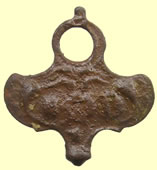 |
 |
 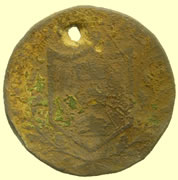 |
|||||
| Georgian watch winders | 18thC clog fastner | 19thC Condor token Halfpenny token of Hull, Yorkshire, dated 1791.
|
|||||
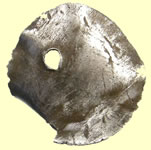 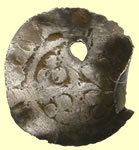 |
 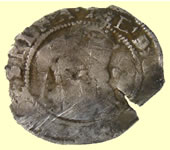 |
||||||
| Medieval long cross hammered silver penny | 1572-3 Elizabeth 1st hammered silver half groat | ||||||
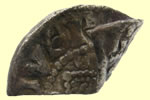 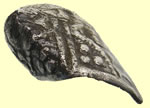 |
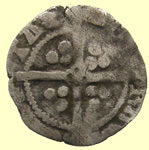  |
||||||
| 1247 Henry III hammered silver voided long cross half penny | 1413 AD Henry V hammered silver penny Quatrefoil with pellet reverse cross Rev CIVI/TAS/EBO/RACI - York mint |
||||||
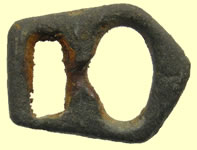 |
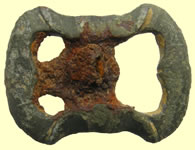 |
 |
 |
||||
| Medieval buckle | Cast copper alloy trapezoidal shoe or knee buckle with concave sides 1660-1720 |
RN Capt / Commander - 1812 RN Lieutenant - 1812 RN Midshipman - 1812 RN Volunteer Gr.I - 1812 After this issue a Midshipman will have the Captain's style |
1500-1700 mount | ||||
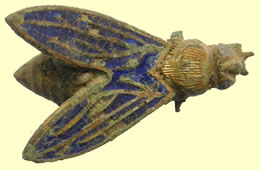 |
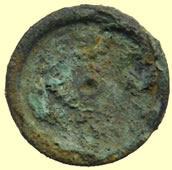 |
 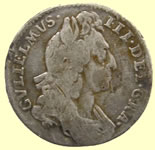 |
|||||
| Edwardian enamelled brooch | Georgian trade weight | 1696 William III milled silver sixpence | |||||
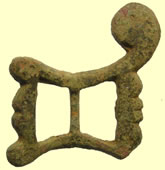 |
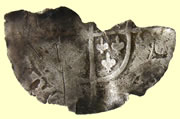 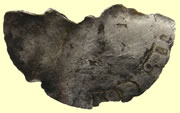 |
||||||
Post-medieval copper alloy double-looped buckle frame, both loops trapezoidal. The very distinctive form is as Whitehead 2003 no. 527 c.1620 - c.1680 |
1554 Mary hammered silver groat | ||||||
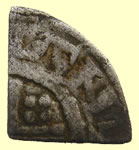 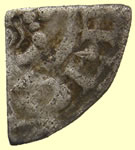 |
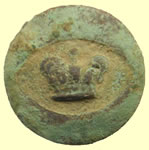 |
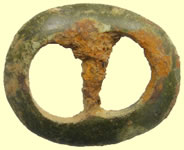 |
|||||
| 1215 Henry III hammered silver short cross farthing | Possible local govt button | Cast copper alloy double-looped sub-annular shoe or knee buckle with bevelled internal edge Circa 1650-1720 |
|||||
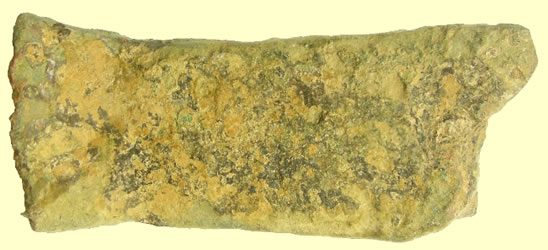 |
 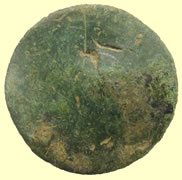 |
||||||
| Medieval pot leg | 18thC French copper coin | ||||||
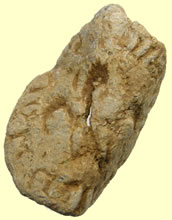 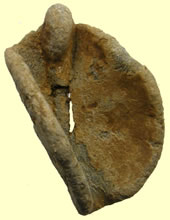 |
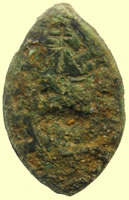 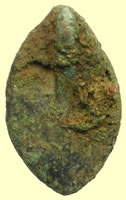 |
||||||
Circa 1260 AD lead personal seal , 4 have been found attached to pasture rights. The design is typical of mid 13thC non heraldic seals |
13th C bronze Vessica seal matrix - needs a soak and pick to clean legend and impression | ||||||
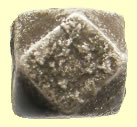 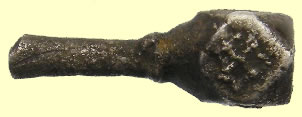 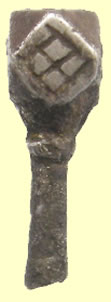 |
|||||||
Very unusual silver pin - possibly late medieval - reported to Colchester museum as possible treasure All faces have different pattern |
|||||||
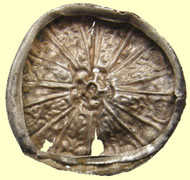 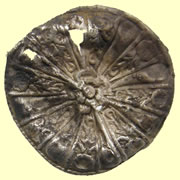 |
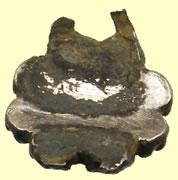 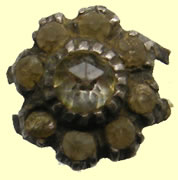 |
||||||
| Silver button face with Tudor rose design - reported to Colchester museum as possible treasure | Possible Tudor period gilded silver and glass stone mount - reported to Colchester museum as possible treasure | ||||||
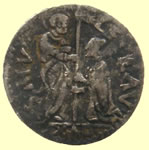 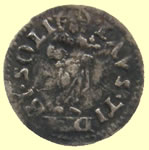 |
  |
||||||
1501-1521). Rev: LAVS TIBI SOLI (Thee Alone be Praised). Haloed figure of Christ holding a cross. Obv: LE LAV DVX S M V (Leonardo Lauredan, Doge. St Mark of Venice.) Doge kneeling before Saint Mark. |
1634 Charles 1st hammered copper rose farthing | ||||||
 |
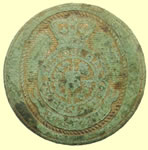 |
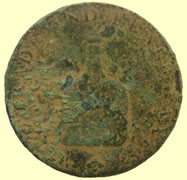 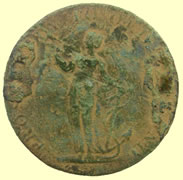 |
|||||
| 15thC lead token type 2 | HONI SOIT QUI MAN Y PENSE PACKET Honi soit qui mal y pense (Old French: shame upon him who thinks evil of it) RN - Packet Service c.1800-1811 |
c1795 Norfolk Norwich Halfpenny Condor TokenOBVERSE: A bottle. MORE TRADE AND FEWER TAXES. REVERSE: A figure of Hope, standing holding anchor. PROPERITY TO OLD ENGLAND. EDGE: RICHARD DINMORE & SON NORWICH |
|||||
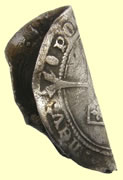 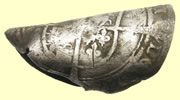 |
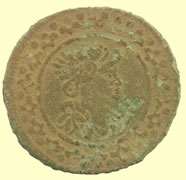 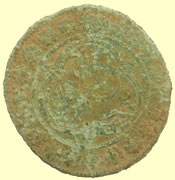 |
||||||
| Taco'd Rare 1551-3 Edward VI hammered silver sixpence - Tun mintmark | Very unusual Jetton as this purports to be a 16thC Mercury bust Jetton of one of the Kravwinckel or Lauffer families, howvever it only has a series of flowers as a legend both sides ?? Not listed in Mitchener |
||||||
  |
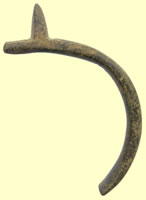 |
||||||
| Georgian decorated copper cane end | Medieval prick spur | ||||||
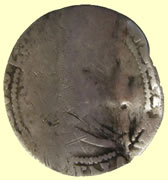 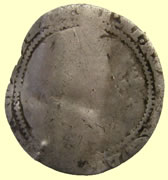 |
 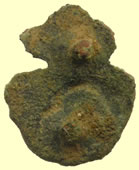 |
||||||
| 1603 James 1st Irish hammered silver 6 pence | Medieval mount | ||||||
 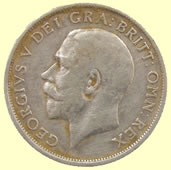 |
 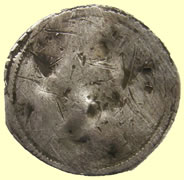 |
||||||
| 1917 George V milled silver shilling (12 pence) | 1561 Elizabeth 1st hammered silver groat - clipping a coin like this would have got you hung back then !! | ||||||
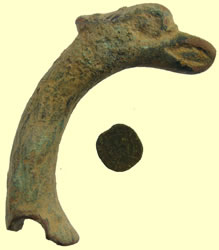 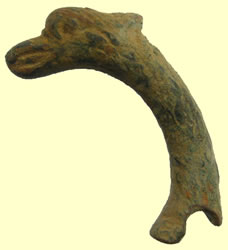 |
 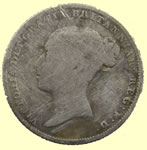 |
||||||
| These huge bird headed mounts appear in my ref books as Roman but I am not convinced as they look in too good a shape to be that old - needs more research | 1856 Victoria milled silver sixpence | ||||||
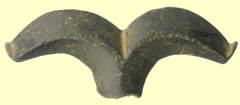 |
|||||||
| Medieval barrel tap handle | |||||||
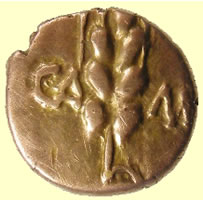 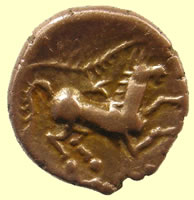 |
|||||||
10 to 40 AD Northern Celtic gold 1/4 stater of Cunobelin - sent to CCI for recording and confirmed ID Cunobelin wild type quarter, 1.34g,10.8mm |
|||||||
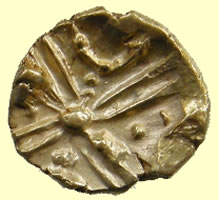 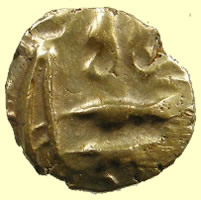 |
|||||||
Circa 70 BC Celtic gold qtr stater - first off this type I have seen - sent to CCI for recording and confirmed ID Possible Ingoldisthorpe quarter, ABC 2448, not in VA or BMC. Another extremely rare type, 1.42g, 13.55 mm |
|||||||
Fantastic 1704 Queen Ann silver button - never seen a button with a Queens legend - reported to museum as treasure |
|||||||
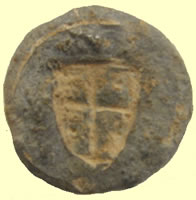 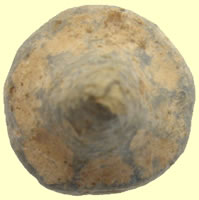 |
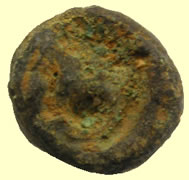 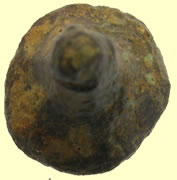 |
||||||
| First lead circa 13thC medieval bell shaped seal matrix I have seen | Unusually small medieval bell shaped seal matrix - needs cleaning to see impression | ||||||
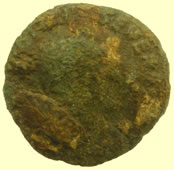 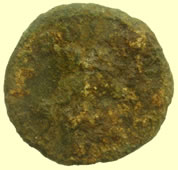 |
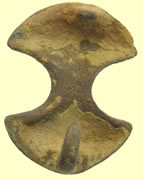 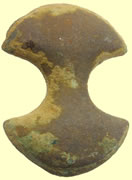 |
||||||
3rdC Roman bronze coin sent for ID As far as I can tell from the visible obverse legend fragment "...SEVERV...", this seems to be one of the Æ denominations - you didn't give me a diameter so whether it's an As, a Sestertius, or one of the Æ so-called "Limes Denarii" relatively common in that era is uncertain - of either Septimius Severus (193-211) or Severus Alexander (222-235). The former had a significant connection with Britain. In fact he died there (in York, to be exact) in 211 after overseeing repairs to Hadrian's wall. Severus Alexander, was not so much concerned with Britain as far as I know - for one thing, he came to the throne at the age of only 14. Also, by then things were beginning to seriously threaten to become "sticky" in the Continental parts of the Empire and the new Sasanid line of Persia was inspiring the Roman Empire's old antagonist in the East to pose a new threat. It's reasonable to assume Britain and its situation was not high on the agenda of Severus Alexander's concerns. Mark |
A cast copper alloy mount Post-Medieval date (1500-1700 AD). | ||||||
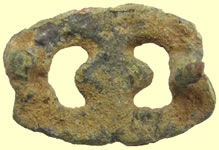 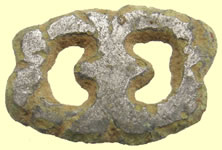 |
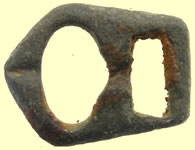 |
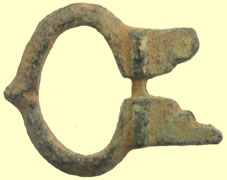 |
|||||
| Medieval mount | Medieval buckle | Circa AD 1250 - 1400 - buckle with integral plates | |||||
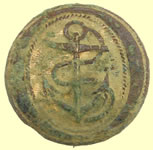 |
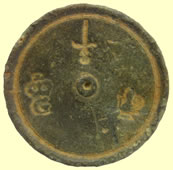 |
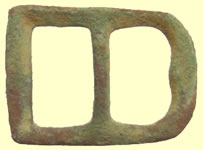 |
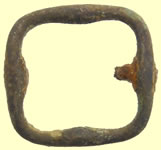 |
||||
RN Capt / Commander - 1787 RN Lieutenant - 1787 |
George II trade weight - Crown G cipher London | Cast asymmetrical buckle frame with a narrowed pin bar Circa AD 1575 -1700 |
Circa 1650-1720 | ||||
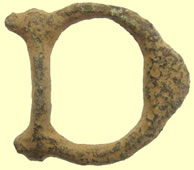 |
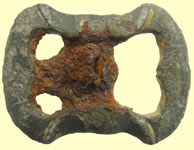 |
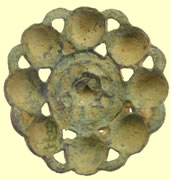 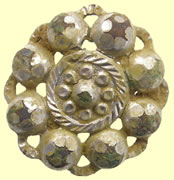 |
|||||
Post Medieval cast copper alloy single loop buckle frame. 1500-1650 AD |
Cast copper alloy trapezoidal shoe or knee buckle with concave sides 1660-1720 |
20thC mount | |||||
 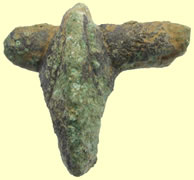 |
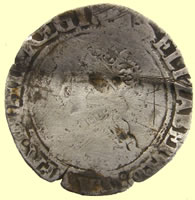 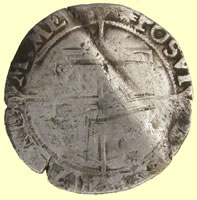 |
||||||
| 2ndC Rokman head studd type fibular brooch | 1584-6 Elizabeth 1st hammered silver shilling | ||||||
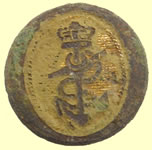 |
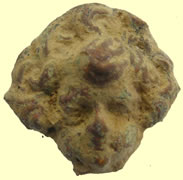 |
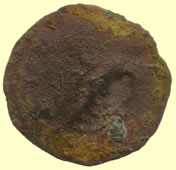 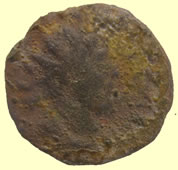 |
|||||
RN Capt / Commander - 1812 |
Georgian chrub mount | Mid 4thC Barbarous radiate Roman copper coin - sent for ID The problem with a piece like this is that in the absence of even a single distinguishable letter in the obverse legend, we have to work from portraiture alone - not the best way to go as the portraits were already losing the signficant realism of the 2nd & earlier 3rd centuries. It appears from the portrait to be a younger (or youngish) ruler, so my 1st question would be whether it shows any signs of being silver or billon. Younger folks issuing significant numbers of antoniniani like Elagabalus, Gordian III, Philip II and Herrenius Etruscus mostly had enough silver in their antoninianus alloys for their coins to at least clean-up to a silvery appearance. Despite this, the portrait stylistically seems to be "earlier" rather than "later" in the antoninianus era. It doesn't look like Aurelian or any of the folks who followed him with the possible exception of Numerian, but the style isn't right for that era - after Aurelian the busts tended to be smaller in relationship to the flan - so we're not left with a whole lot of possibilities here. This might be Gallienus, although the portrait doesn't look much like him. The other possibility would be Tetricus II of the Gallic Empire, although he mostly tends to be portrayed looking very child-like. I'd say the portrait most resembles Gordian III or Philip II - but they both struck in reasonably good silver. Sorry I can't give you a better ID on this one, but without any help from legends it's going to be a tough call at best. Mark |
|||||
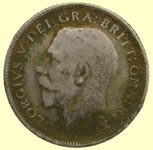  |
 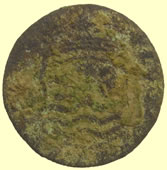 |
||||||
| 1923 George V milled silver sixpence | 1747 Dutch Zeelandia provence copper coin | ||||||
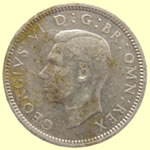  |
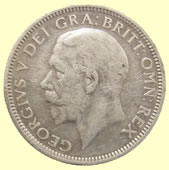  |
||||||
| 1942 George VI milled silver sixpence | 1935 George V milled silver shilling ( 12 pence) | ||||||
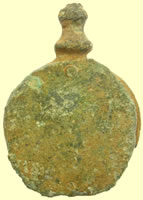 |
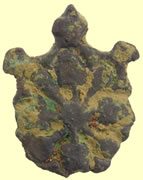 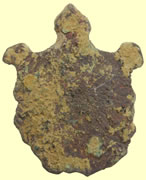 |
||||||
| Not certain what this is ?? reminded me of a mirror handle - suggestion it is a clock pendulum | 1500-1700 mount | ||||||
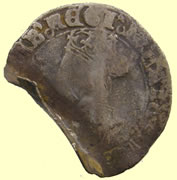 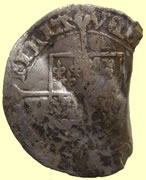 |
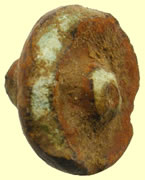 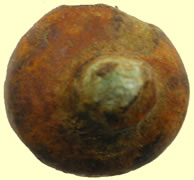 |
||||||
| 1554 Mary hammered silver groat | Roman bronze mount | ||||||
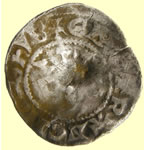 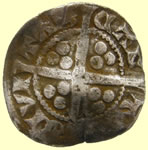 |
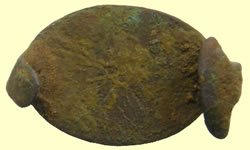 |
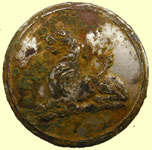 |
|||||
1341 Edward III hammered silver penny - Florin issue Obv EDWAR ANGL DNS HYB Rev CIVI/TAS/CAN/TOR - Canterbury mint |
18thC clog fastner | 19thC livery button | |||||
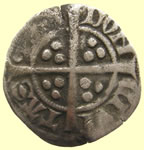 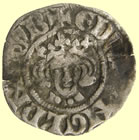 |
|
||||||
1272 Edward 1st hammered silver penny - Cross Pattee - Class 4e - First Class 4e I have seen - unusual 3 pellets on breast Obv EDWR ANGL DNS HYB Rev CIVI/TAS/LON/DON - London mint |
Anglo Saxon buckle | ||||||
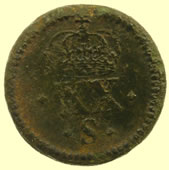 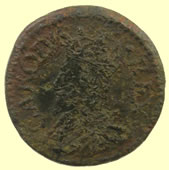 |
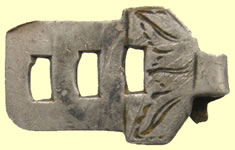 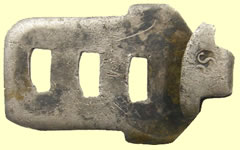 |
||||||
1634 Charles 1st goin coin weight - twenty shillings (gold Unite) Obv Bust and legend of Charles 1st Rev Crown XXs
|
18thC silver decorated clog fastener - Maker SC | ||||||
 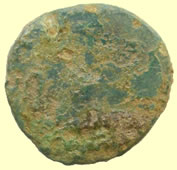 |
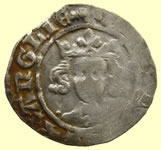 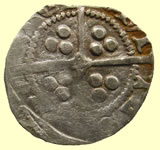 |
||||||
| 4thC House of Constantine Roman bronze coin | 1434-1435 Henry VI hammered silver penny - quadrefoil with pellet on rev Satire stops Obv ** REX ANGLIE CIVI/TAS Type |
||||||
 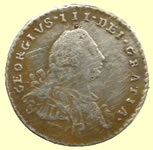 |
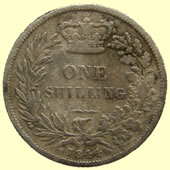 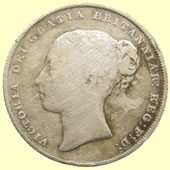 |
||||||
| Tiny 1800 George III milled silver penny | 1844 Victoria milled silver shilling | ||||||
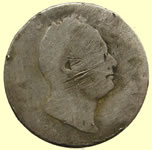 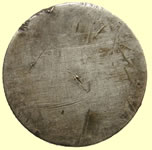 |
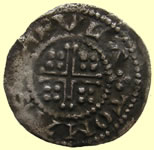 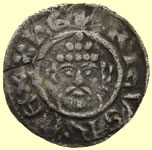 |
||||||
| 1834 William III milled silver sixpence | Rhuddlan (Welsh) mint - Cross is Cross pattee, a cross with pellet ends 1180 Henry II hammered silver short cross penny - Group 1 coin Obv HENRICVS REX Rev + TOMAS ON RVLA - Tomas of Rhuddlan mint (wales) |
||||||
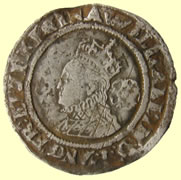 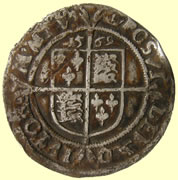 |
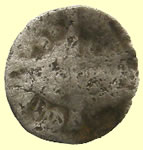 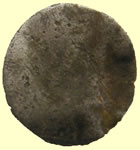 |
||||||
| 1569 Elizabeth 1st hammered silver sixpence - Coronet mint mark | 1341 Edward III hammered silver farthing | ||||||
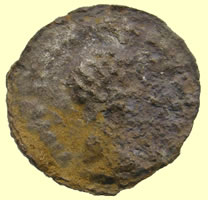 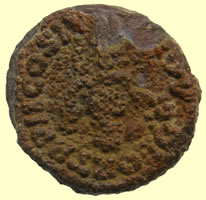 |
|||||||
| 2ndC Roman silver coin - 'cooking' to remove crust | |||||||
 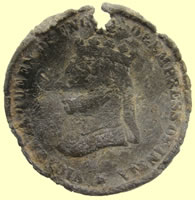 |
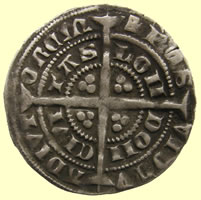 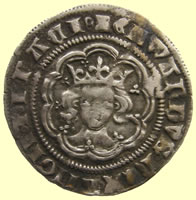 |
||||||
1887 Victoria Queen of England and Empress of India medallion 1837 -1887 Gold Jubilee |
1352-1353 Edward III hammered silver half groat - Pre treaty series D Obv EDWARDVS REX AIIGL Z FRACI Rev CIVI/TAS/LOND/DON - London mint 2.20g, 23.45mm |
||||||
 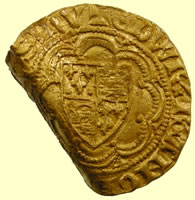 |
|||||||
1361 Edward III hammered gold 1/4 nobel Obv + EDWR + R ++ ANGLIE DVNS HY Edward III (1361), Quarter-Noble, Transitional Treaty Period, quartered shield of arms, two pellets in upper left quarter, within beaded and linear tressures of eight arcs, pellets on cusps, fleur trefoils in spandrels, all within beaded circle, comma and saltire stops in legend, +edwr;r; anglie: dnvs; hv rev ornamental cross potent with annulets in angles and at centre, lis terminals, lions in angles, lis above lion in fourth quarter, within beaded and linear tressures of eight arcs, trefoils in spandrels, beaded circle surrounding, saltire stops in legend, +exaltabitvr: in: gloria 18.99mm, 1.93g |
|||||||
 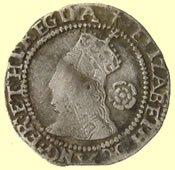 |
|
||||||
| 1572 Elizabeth 1st hammered silver 3 pence | 1817 George III milled silver shilling and an 1817 George III milled silver shilling forgery off same site | ||||||
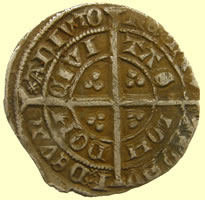 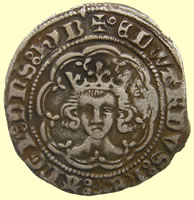 |
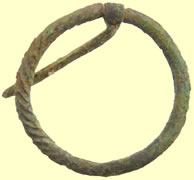 |
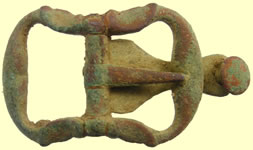 |
|||||
1361- 1369 Edward III hammered silver half groat - Treaty B London Coss Potent Trefoil on breast - double annulet stops and satires Obv EDWARDVS REX ANGL DNS HYB Rev POSV/DEVM/+ADIVTO/REMEV CIVI/TAS/LOND/DON - London mint
|
Medieval annular brooch | Cast copper alloy trapezoidal shoe or knee buckle with concave sides 1660-1720 |
|||||
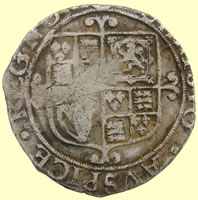 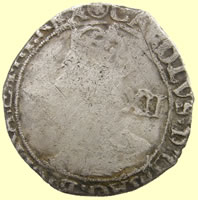 |
 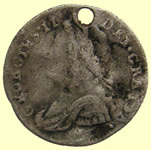 |
||||||
| 1641-3 Charles 1st hammered silver shilling (12 pence) Tower mint under Charles - Triangle in circle mint mark | Tiny 1740 George II milled Maundy silver penny | ||||||
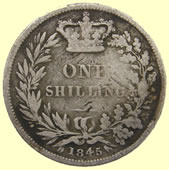 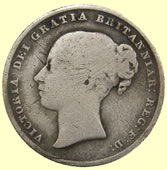 |
|
||||||
| 1845 Victoria milled silver sixpence | Medieval purse bar with hexagonal knops | ||||||
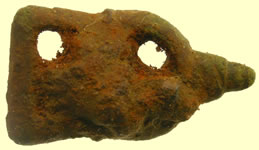 |
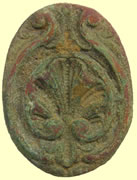 |
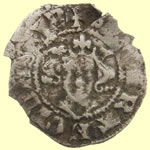 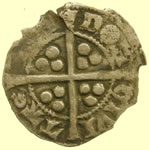 |
|||||
Cast asymmetrical buckle frame with a narrowed pin bar Circa AD 1575 -1700 |
Georgian mount | 1341 Edward III hammered silver florin penny Obv EDWAR ANGL DNS HYB Rev CIVI/TAS/LOND/DON - London mint |
|||||
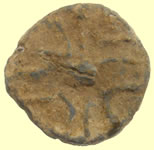 |
 |
|
|||||
| 15thC lead token | Post-Medieval (1500-1700) copper alloy belt mount in the form of an acorn | Medieval book clasp | |||||
 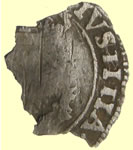 |
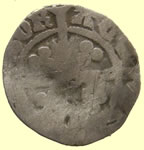 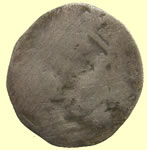 |
||||||
| 1634 Scottish Charless 1st hammered silver twenty pence - XX right of bust | 1272 Edward 1st hammered silver penny - Class 9b Rev CIVI/TAS/EBOR/ACI - York mint |
||||||
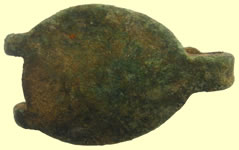 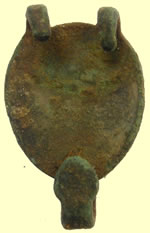 |
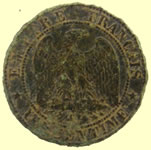 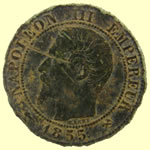 |
||||||
| 18thC clog fastener | 1855 French Napoleon III copper coin | ||||||
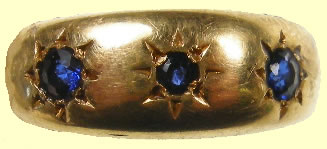  |
|||||||
1909 18 carat gold ring - Chester hallmark - Maker JH & S - John Hamilton & Son 18.89mm,3.79g |
|||||||
Stunning 13thC seal matrix Triple dot makers mark + I'IR DIG ' ZTOEC H ' II 'R' |
|||||||
  |
  |
||||||
1247 Henry III hammered silver voided long cross half penny Moneyer Richard of Canterbury mint |
1247 Henry III hammered silver voided long cross half penny Moneyer Nicole of London mint |
||||||
|
|||||||




